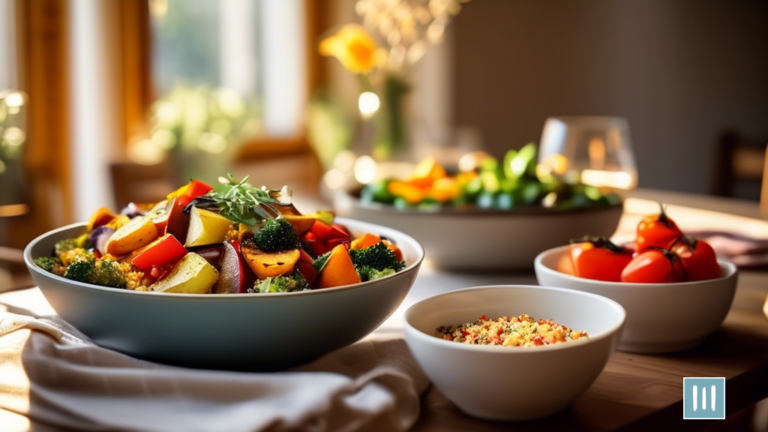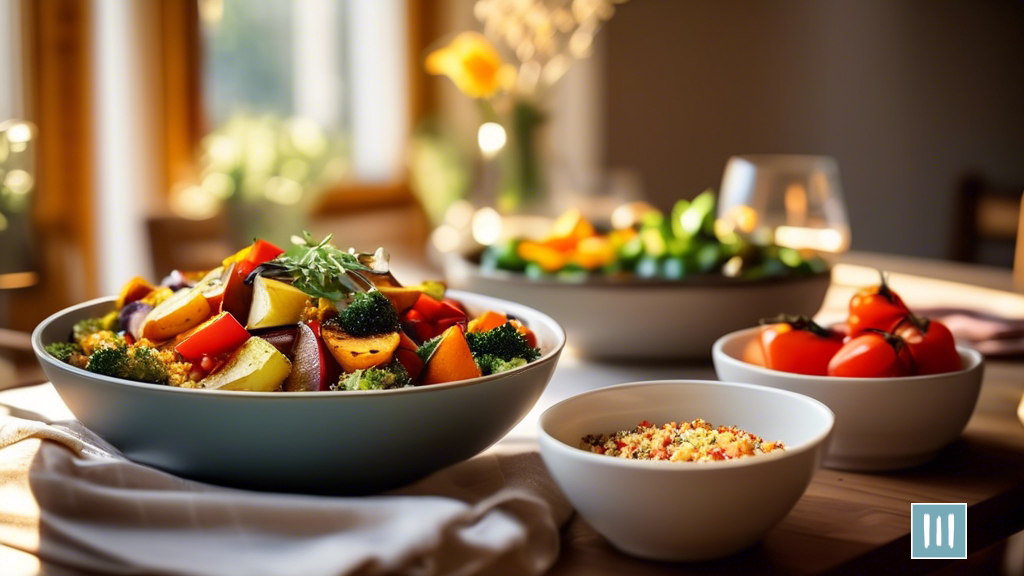Are you looking to create delicious and wholesome meals that will not only satisfy your taste buds but also nourish your body? When it comes to meal planning, it’s important to focus on balance and variety to ensure you’re getting all the nutrients you need.
In this article, we will explore healthy dinner ideas that incorporate plant-based protein options, whole grains, colorful vegetable medleys, lean protein sources, and healthy fats and oils to help you create well-rounded and satisfying meals.
Whether you’re a seasoned chef or just starting out in the kitchen, these dinner ideas will inspire you to get creative with your meal planning. By incorporating a variety of nutrient-dense ingredients, you can create meals that are not only delicious but also packed with essential vitamins and minerals.
Key Takeaways
- Focus on balance and variety in meal planning for nutrient intake
- Incorporate lentils, quinoa, and farro for plant-based protein and whole grains
- Include colorful vegetable medleys for visual appeal and nutrition
- Choose lean protein sources like chicken, tofu, fish, and legumes for muscle repair and satiety
Plant-Based Protein Options
If you’re looking to add more plant-based protein to your diet, lentils are the shining stars that will keep you satisfied and energized throughout the day. Lentils are versatile legumes that can be used in a variety of dishes, from soups and stews to salads and curries. They are not only high in protein but also rich in fiber, iron, and folate, making them a nutritious choice for a balanced meal.
Incorporating lentils into your meals is not only good for your health but also delicious and satisfying. You can make a hearty lentil soup with vegetables and spices for a cozy dinner, or a refreshing lentil salad with fresh herbs and a tangy dressing for a light and nutritious meal. The possibilities are endless when it comes to cooking with lentils, so get creative and enjoy the benefits of adding plant-based protein to your diet.
Incorporating Whole Grains
When it comes to incorporating whole grains into your meals, don’t forget to mix in quinoa and farro for added fiber and nutrients. Quinoa is a versatile grain that can be used in salads, as a side dish, or even in stuffed bell peppers.
Farro, on the other hand, has a nutty flavor that pairs well with roasted vegetables or as a base for a grain bowl. By including these whole grains in your meal planning, you not only add a delicious element to your dishes but also increase the nutritional value of your meals.
Incorporating whole grains like quinoa and farro into your dinners not only provides a satisfying texture but also helps keep you full and energized throughout the evening. Whether you’re looking to create a hearty grain salad or a comforting grain bowl, these whole grains can easily be incorporated into a variety of dishes.
So next time you’re planning your meals, remember to include quinoa and farro for a wholesome and balanced dinner that will leave you feeling nourished and satisfied.
Colorful Vegetable Medleys
Create a vibrant mix of colorful vegetable medleys to add variety and nutrition to your plate. Vegetables aren’t just packed with essential vitamins and minerals, but they also bring a burst of flavor and texture to your meals.
Try experimenting with different combinations of vegetables to keep your dinners exciting and satisfying.
- Roasted bell peppers, zucchini, and cherry tomatoes tossed in olive oil and herbs
- Stir-fried broccoli, carrots, and snap peas with a soy sauce and ginger glaze
- Grilled eggplant, red onions, and asparagus drizzled with balsamic vinegar
- Sauteed spinach, mushrooms, and red bell peppers seasoned with garlic and lemon juice
By incorporating a variety of colorful vegetables into your meals, you not only enhance the visual appeal of your dishes but also ensure that you’re getting a wide range of nutrients to support your overall health. So, get creative in the kitchen and let the vibrant colors of your vegetable medleys brighten up your dinner table.
Lean Protein Sources
Looking for lean protein sources for your meal? When it comes to creating a balanced and healthy dinner, incorporating lean proteins is key. Not only are they essential for muscle repair and growth, but they also help keep you feeling full and satisfied. Consider adding grilled chicken breast, turkey breast, tofu, tempeh, or fish such as salmon or tilapia to your dinner rotation. These options are not only delicious but also packed with nutrients to nourish your body.
Another great lean protein source to consider is legumes like lentils, chickpeas, and black beans. These plant-based proteins are not only low in fat but also high in fiber, making them a great choice for a healthy dinner. You can easily incorporate them into soups, salads, or stir-fries for a satisfying and nutritious meal. Don’t forget about eggs as well – they’re a versatile protein option that can be enjoyed in a variety of dishes from omelets to frittatas.
Healthy Fats and Oils
Indulge in dishes with good fats and oils to enhance your meal experience. Incorporating healthy fats like avocados, nuts, seeds, and olive oil not only adds a delicious richness to your meals but also provides essential nutrients for your body. Whether you’re drizzling some olive oil over a salad or adding sliced avocado to your sandwich, these fats can elevate the flavors and textures of your dishes while supporting your overall well-being.
When choosing oils for cooking, opt for options like coconut oil or avocado oil, which have high smoke points and are stable at high temperatures. These oils are great for sautéing, roasting, and baking without compromising their nutritional benefits. By including these healthy fats and oils in your meals, you’re not only creating delicious dishes but also nourishing your body with the nutrients it needs to thrive.
Frequently Asked Questions
Can I substitute tofu for tempeh in plant-based protein recipes?
Yes, you can substitute tofu for tempeh in plant-based protein recipes! Tofu is a great alternative with a similar texture and taste. Experiment with different marinades and cooking techniques to find your favorite combination.
How can I incorporate quinoa into my meals if I am gluten-free?
To incorporate quinoa into your gluten-free meals, try making quinoa salads, using it as a base for stir-fries, or mixing it into soups and stews. Quinoa is a versatile and nutritious option for balanced meal planning.
What are some creative ways to sneak vegetables into meals for picky eaters?
Struggling with picky eaters? Sneak veggies into meals by blending them into sauces, adding them to smoothies, or disguising them in casseroles. Your loved ones won’t even notice, but their health will thank you!
Are there any plant-based sources of omega-3 fatty acids?
Yes, there are plant-based sources of omega-3 fatty acids! Include chia seeds, flaxseeds, hemp seeds, walnuts, and algae oil in your diet. These options can help support your overall health and well-being.
Can I use coconut oil instead of olive oil for cooking?
Yes, you can use coconut oil instead of olive oil for cooking! Did you know that coconut oil is high in saturated fats, which can boost your good cholesterol levels? It’s a tasty and healthy swap!

















